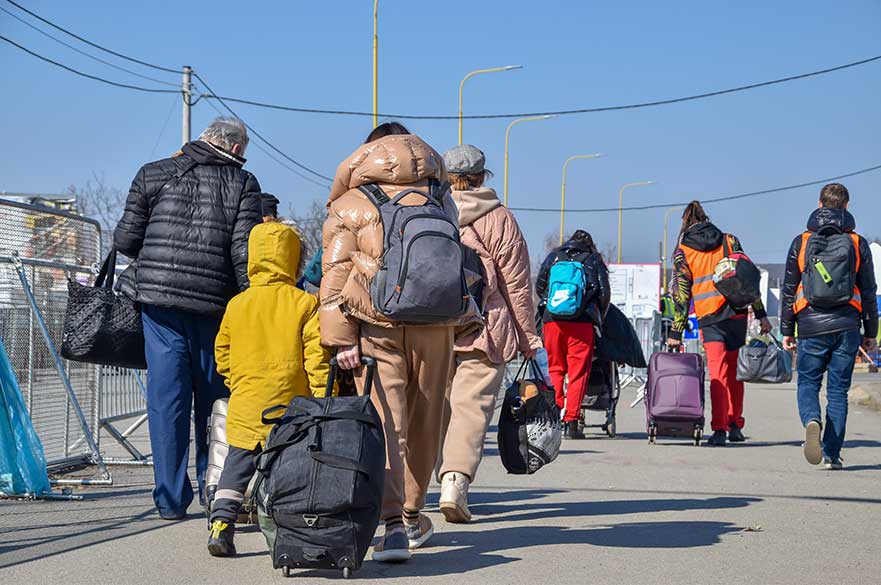NLS student blog: Why asylum seekers don't stop at the first safe country
LLM International Human Rights Law student, Yazdan Kargaran, writes about the recent declarations of the Archbishop of Canterbury and Robert Jenrick around immigration law and whether or not they reflect the principles of International Refugee Law.

The powerful speech of the Archbishop of Canterbury in the House of Lords to criticise the “Illegal Migration Bill” and, following this, the interview of immigration minister Robert Jenrick with Channel 4 to support the Bill prompted me to rethink some of the controversial issues in the case of asylum seekers, and in particular, the minister's comment regarding the fact that who seek asylum, according to the Refugee Convention, should submit their application in the first safe country they arrive. Is this really the case?
As we enter the realm of international law, we discover that asylum standards are more complicated than they first appear. International law does not require all countries to grant asylum to all applicants. Rather, it is based on fundamental principles of international refugee and human rights law, namely the principle of non-refoulement. This principle requires nations to assess asylum claims and offer protection to those in genuine need, not only at the national level but also globally.
But what does the right to seek asylum mean? For the right to seek asylum to be meaningful, it should not be limited to the ability to seek protection. It should include the right to participate in asylum procedures and, most importantly, the freedom to seek refuge elsewhere.
A person has a fundamental right to seek asylum in any nation, including their country of origin. Reasons for seeking asylum can range from war and persecution to other serious threats to a person's safety. The right to seek asylum includes the right to leave the country. In the majority of international human rights frameworks, asylum aims to give individuals the opportunity to find protection in a new country. The Universal Declaration of Human Rights (UDHR) and the International Covenant on Civil and Political Rights (ICCPR) are examples.
Looking for a safe country
In the UDHR Article 13(2), the right to leave a country is emphasised just before the right to seek asylum, while in the ICCPR Article 12, it is explicitly defined as a responsibility that states must fulfil. This underlines the fundamental nature of the freedom to leave a country, which is inextricably linked to the right to seek asylum.
The intersection between the right to leave, the right to seek asylum and the principle of non-refoulement is a crucial aspect of international law. The state has two obligations in this situation: firstly, it must not impede a person's departure, and secondly, it must provide the necessary travel documents, especially to its citizens. However, it is essential to remember that the right to leave does not inherently imply the right to enter another state. States are not obliged to admit non-citizens or persons with weak ties or claims to the nation.
In its most basic form, the right to leave the territory involves temporary movement to realise interrelated rights such as personal liberty, the prevention of arbitrary detention or exile, the right to seek asylum and the prohibition of arbitrary deprivation of nationality. Furthermore, this privilege is fundamental to freedom of thought and expression, as it emphasises the unrestricted exchange of ideas across borders. However, balancing this individual right with the interests of states is a significant challenge.
The right to leave one’s country is also essential, especially when obtaining protection. A person fleeing her or his country of origin for fear of persecution should not be rejected or returned without a thorough examination of her or his application. Under international law, practices that prevent people from exercising their right to leave their country, thereby exposing them to the possibility of persecution, constitute a violation of their rights. In such circumstances, other states are obliged under international law to respect the right to leave to seek asylum and to avoid any action that might impede efforts to obtain adequate protection. The principle of non-refoulement supports this view at the border and the prohibitions on expulsion under human rights law, which limit the ability of states to expel persons from their territory.
Protection under Article 31 of the Refugee Convention
Article 31 of the 1951 Refugee Convention recognises that due to the urgency and often precarious nature of their flight, refugees may seek to enter a state without the appropriate documentation. Therefore, it states that states should not punish such refugees for entering the country illegally. The absence of documentation does not diminish the veracity of their need for protection. Furthermore, restrictive immigration policies can often force refugees to use unorthodox methods of escape. Protocols against migrant smuggling and human trafficking should be implemented with the protection of refugee rights in mind, including the non-refoulement principle, which prohibits refugees from returning to unsafe locations.
The “Safe Country”
Under international law, states must examine asylum claims within their jurisdiction. However, many states evade this responsibility using the “safe country” rule. Under this rule, if asylum seekers could have been protected elsewhere, they are transferred to a country deemed safe without further examination of their case. This method often results in accelerated procedures and generally limits or removes rights of appeal.
States justify the “safe country” rule because genuine refugees will seek asylum in the first non-threatening state they encounter. Therefore, further movement is seen as an attempt to migrate and not to seek safety. This argument is flawed because it does not consider the particular situation of asylum seekers. For example, a country considered safe may be unsafe for specific groups. Furthermore, international law does not require refugees to seek asylum in the first safe country they encounter.
Although “safe country” regulations are widespread, their implementation presents practical and legal challenges. They often add complexity to already overburdened asylum systems and can lead to unforeseen problems such as increased human trafficking, making borders more dangerous and chaotic.
Protecting Asylums Effectively
The concept of “safe country”, which appears in various contexts such as a safe country of origin or a safe first or third country of asylum, raises the fundamental question of whether asylum seekers have access to adequate protection. From an international law perspective, the primary concern is the security of the state to which the asylum seeker may be sent. Other considerations include the procedural safeguards in the third state and the state’s relationship with the asylum seeker.
However, the term “effective protection” is frequently used by states without a distinct and uniform definition. Before transferring an asylum seeker to a third country, states must ensure that the third country offers “effective protection” in accordance with their non-refoulement and human rights obligations. Acceding to human rights and refugee conventions does not guarantee compliance with their standards. Non-refoulement is essential but insufficient to ensure adequate protection.
Under certain conditions and with appropriate individual safeguards, United Nations High Commissioner for Refugees (UNHCR) suggests that transferring asylum claims to another country may be acceptable. However, no returns should be based solely on a list of “safe” countries. The situation and risks of each individual, including their origin and history, must be assessed.
In 2004, UNHCR’s Director of International Protection explained that protection could only be considered adequate if there is no risk of persecution, refoulement or torture, no real threat to the life of the person, a genuinely accessible and durable solution, no arbitrary expulsion or deprivation of liberty, sufficient means of subsistence, preservation of the unity and integrity of the family and recognition of specific protection needs.
Protection can only be considered “effective” in a third state if several conditions are met:
- The asylum seeker does not fear persecution.
- She or He does not risk being sent to a state where she or he does not enjoy effective protection.
- She or He has sufficient means to maintain an adequate standard of living.
- International standards respect her or his fundamental human rights.
In addition, the third state must expressly consent to admit the person as an asylum seeker or refugee. It must respect international refugee and human rights law in practice, not just theory. Other factors include access to fair and effective determination procedures, considering the particular vulnerabilities of the individual and protecting the family's right to privacy.
Conclusion
Under international refugee law, Robert Jenrick’s assertion that asylum seekers must register in the first safe country they arrive in is inaccurate, as it is, in fact, not an obligation. Although this is a widely accepted interpretation implemented by many states, it does not accurately reflect the principles set out in the Refugee Convention or in other international human rights laws.
A refugee has the fundamental right to seek asylum in any country and abandon her or his country of origin or any other country and seek protection elsewhere.
Furthermore, the “safe country” rule should not restrict the right to seek asylum. This rule, which is frequently used by states to avoid having to examine asylum applications under their jurisdiction, tends to ignore the particular circumstances and needs of asylum seekers. While this rule may speed up procedures, it may also contribute to complex problems, such as an increase in human trafficking and a possible violation of the principles of non-refoulement.
Ultimately, the question is not simply which country an asylum seeker reaches first but whether effective protection, as defined by international law, is actually available. This involves assessing factors such as the risk of persecution, access to livelihoods, respect for human rights and family unity, among others.
In light of the above, it can be concluded that Jenrick’s assertion is inconsistent with the overall provisions and ethics of international refugee law.
Yazdan Kargaran, LLM in International Human Rights Law
- Subject area: Law, criminology and justice
- Category: Nottingham Law School


